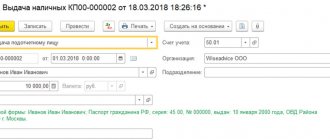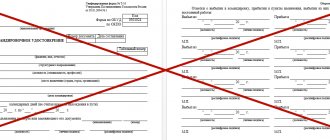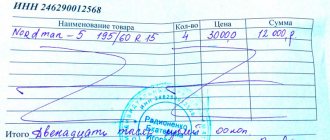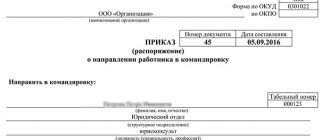Postings for accounting for travel expenses: calculation example
Documents confirming this type of expense are travel documents, tickets, a vehicle rental agreement, as well as other documents confirming the fact of payment.
Accounting and postings The Chart of Accounts contains account 71 “Settlements with accountable persons”, which is used to account for all settlements with an employee sent on a business trip. The debit of account 71 records the amounts issued to the traveler, and the credit includes travel expenses and the return of unspent amounts. Upon departure, based on the advance report, the employee receives a certain amount of money; the receipt of funds is reflected by posting D71 K50. When returning, the employee may have some amount left; in this case, it is returned to the enterprise’s cash desk, while a cash receipt order is filled out and posting D50 K71 is performed. There are foreign business trips, in which case the employee is given money in foreign currency. With this calculation, you need to open a sub-account “Calculations in foreign currency” in addition to account 50. Also, for accounting, the rate is set according to the Central Bank of the Russian Federation on the date of execution of the advance report.
Important An entry is made in the accounting: D26 “General business expenses” K71 “Settlements with accountable persons” (business trip expenses are reflected) and D71 “Settlements with accountable persons” K91 “Other income and expenses (exchange rate differences are reflected). 3. Documents confirming expenses during a business trip are: air and railway tickets, receipts and bills for accommodation, various checks, as well as statements from terminals and ATMs. Based on all these documents, an advance report is generated. Expenses are recognized in the period in which they are incurred. 4.
What's in accounting
After checking the expediency of expenses, whether they were targeted or not, the arithmetic side of the documentation, the accountant checks the documents attached to the report.
In accounting, when the advance report for a business trip is approved, the postings will be as follows:
| Situation | Wiring |
| Employee purchase of materials | Dt 10 – Kt 71 |
| When purchasing goods | Dt 41 – Kt 71 |
| Writing off daily allowances | Dt 20 Kt 71 |
| Return of unclaimed money to the company's cash desk | Dt 50 – Kt 71 |
| Return of unclaimed money to the current account | Dt 51 – Kt 71 |
| Additional payment of money to the employee if he had to invest his own | Dt 71 – Kt 50 or Dt 71 – Kt 51 |
| The employee did not provide supporting documents or incurred inappropriate expenses. The amount is written off as a deficiency | Dt 94 – Kt 71 |
| The shortfall is withheld from the employee | Dt70 – Kt 94 |
Using the information provided in the article, you will not have to experience difficulties in drawing up an advance report for a business trip , and the accounting department will not have difficulty reflecting transactions in accounting.
The following is a sample of how to fill out an advance report for a business trip in 2020 .
Registration of a business trip: documents, expenses, postings
You will need
- - supporting documents;
- — chart of accounts;
- - calculator.
Instructions 1. Check the correctness of the supporting documents. The costs indicated therein must be economically justified. When purchasing with cash, you are required to provide a receipt and loss statement. In these documents, check the company details, the date and time of purchase, and the name of the product. A loss-making product must strictly contain the blue seal of the organization. 2.
Attention: After everything has been checked, start filling out the advance report. In the very top line, write the name of the company and enter the code of your enterprise (OKPO). 3. Write the document number and the date the report was compiled. Enter the name of the structural unit, indicate the reporting person, position and his timesheet number.
Per diem and other expenses for travel on official business are documented, justified and related to the acquisition of income. 4. But in the Tax Code of the Russian Federation there are reservations that are concluded in the future. For workers who are sent to other cities within the country, a certain amount of daily allowance is established, which can be included in other expenses. And for experts traveling to other countries, a maximum daily allowance is fixed, which reduces the revenue base. You have the right to establish large indemnity amounts by collective agreement, but you will pay tax on amounts exceeding the fixed amount. 5. Pay per diem to employees depending on the number of days spent on a business trip. On weekends and holidays, charge a double amount, but if the employee is given additional time off, calculate the daily allowance based on the established amount. These are the company's expenses normalized in tax accounting, by which it can reduce profits. For business trips in Russia, this norm is 700 rubles. per day, abroad – 2100 rubles. If you give an employee amounts exceeding these limits, you will have to withhold personal income tax. Example of postings Example: An employee is sent on a business trip for 6 days. The tickets were purchased by the organization from the airline. Their cost is 31,270 rubles. Expenses on a business trip to pay for hotels amounted to 13,000 rubles.
(VAT 1983 rubles), for the use of public transport - 250 rubles, entertainment expenses - 3000 rubles. Daily allowances were issued in the amount of 4,200 rubles. and travel allowances in the amount of 12,000 rubles.
How to calculate business trip days for which you need to pay daily allowance
Regardless of the time of departure of the employee on official business, this day is considered a full day.
When an employee returns after 12 o’clock at night, the employer does not have the right to demand that he appear in the office in the morning of the same day: the person is documented to continue to be on a business trip. Read also: Accounting for settlements with contractors
To calculate daily allowances, an accountant in an organization studies transport tickets and the time of arrival and departure, after which he records the exact number of days of stay on a business trip, draws up a report and determines the amount of compensation. The calculation is made by multiplying the number of days by the daily allowance limit established by management.
Tip 1: How to reflect per diem in the expense report
Among the travel expenses paid to the employee in advance, there is also such an item as daily allowance. This is, so to speak, the “pocket money” of the business traveler, which he spends on food and other little things that are quite difficult or impossible to document. Indeed, per diem is an exceptional type of travel expenses, one that the employee is not required to confirm with primary documents. You will need
- advance report form No. AO-1, daily allowance amount
Instructions
1. Advance report - a form that is collectively filled out by the posted worker and the company’s accountant. It serves to justify the write-off of business trip costs in the accounting and tax accounting of the organization. The front of the form states the total amount of the advance received (including per diem) and the remaining balance or overdraft, if any. 2. The reverse side of form No. AO-1 is a table and is prepared for listing documents confirming expenses attached to the expense report. It is filled out by the employee. Since the amount in the “Total” column of this table must correspond to the total report amount written off by the enterprise, the daily allowance must also be mentioned here. But since the employee is not required to submit any documents confirming daily expenses, the columns of the table prepared for the details of the supporting documents remain empty. The employee easily writes in the column “Name of document (expense)”: “Daily allowance from such and such to such and such a date,” and in the column “Amount of expense” - the amount issued as daily allowance. There is no need to write anything more about the daily allowance. The regularity of accounting for these expenses as production expenses is confirmed by documents proving the production nature of the business trip itself, as well as the order to send on a business trip and travel documents. 3. Daily allowances are taken into account by the organization in the amount of actual expenses. The law does not contain limits on the amount of daily allowance; their monetary value is regulated by the internal acts of the organization. In the Tax Code there is a daily allowance standard only for the purpose of calculating personal income tax, but it is not a limitation on the amount of daily allowance itself. However, taking into account the presence of this standard, the advance report must strictly indicate the dates/number of days for which daily allowances are issued.
Tip 2: How to record travel expenses
Almost every boss is faced with the need to go on business trips or send employees to resolve some issues related to the prosperity of the campaign. Such situations, of course, involve certain costs, which are called travel expenses. These expenses are regulated by the Labor Code. You will need
- - expense reports;
- - checks;
- - receipts;
- — air and railway bulletins;
- — different invoices confirming the fact of payment for any services.
1. The organization is obliged to pay travel expenses for its employees, that is, travel costs, rental of living quarters, as well as other expenses that are made with the permission of the boss. Funds must be issued to the employee against an advance report; the amount of money can be either cash or non-cash. When issuing money, you need to reflect this in accounting by further posting: D71 “Settlements with accountable persons” K50 “Cash” or 51 “Current account”. 2. There are foreign business trips, in which case the employee is given money in foreign currency. With this calculation, you need to open a sub-account “Calculations in foreign currency” in addition to account 50. Also, for accounting, the rate is set according to the Central Bank of the Russian Federation on the date of execution of the advance report. An entry is made in the accounting: D26 “General business expenses” K71 “Settlements with accountable persons” (business trip expenses are reflected) and D71 “Settlements with accountable persons” K91 “Other income and expenses (exchange rate differences are reflected). 3. Documents confirming expenses during a business trip are: air and railway tickets, receipts and bills for accommodation, various checks, as well as statements from terminals and ATMs. Based on all these documents, an advance report is generated. Expenses are recognized in the period in which they are incurred. 4. According to PBU, expenses during a business trip relate to ordinary activities and are taken into account when calculating tax in their entirety. So, say, if the trip was associated with the purchase of physical assets, then the funds spent must be included in their cost, but if fixed assets were purchased, then, accordingly, the costs form the initial cost of these assets of the organization.
Tip 3: How to fill out a travel advance report
Business trips or business trips entail some costs, for example, travel, accommodation, communication services, etc. For this purpose, money is issued to the posted worker from the organization’s cash desk. Upon returning, he must account for the amounts spent, providing checks, receipts, invoices, loss accounts, tickets. Based on these supporting documents, the accountant or the employee himself draws up an advance report (form No. AO-1). You will need
- - supporting documents;
- — chart of accounts;
- - calculator.
1. Check the correctness of the supporting documents. The costs indicated therein must be economically justified. When purchasing with cash, you are required to provide a receipt and loss statement. In these documents, check the company details, the date and time of purchase, and the name of the product. A loss-making product must strictly contain the blue seal of the organization. 2. After everything has been checked, start filling out the expense report. In the very top line, write the name of the company and enter the code of your enterprise (OKPO). 3. Write the document number and the date the report was compiled. Enter the name of the structural unit, indicate the reporting person, position and his timesheet number. In the line “Purpose of advance payment” indicate “travel expenses”. 4. Fill out the table. First, enter the amount that was issued in hand. Below, summarize the conclusion, that is, indicate how much money was received and spent. Next to it, write the same thing, only using accounting language, that is, make entries. For this you will need supporting documents. 5. Fill out the back of the form. Enter the date and document number, name, amount of expenses, debit account. Let's say, when purchasing materials, indicate account 10 in debit. After the entries have been made, make a withdrawal. Sign from the accountable person. 6. Return to filling out the first sheet. In the table where it was necessary to indicate accounting entries, indicate the expenses step by step. In debit, enter the same account as on the back of the form, and in credit - 71. 7. Under the table, indicate how many attachments are attached to the form, to do this, count the number of supporting documents. In the upper right corner, approve the report by indicating the amount in words and signing. 8. Next, enter the refund amount from the sub-report, sign the document with the main accountant and cashier.
Why do you need an advance report for a business trip?
If an employee of an organization is given accountable funds, then after a certain period of time the specialist is obliged to report how and for what purposes he spent the allocated advance.
Basically, money is given to employees when they are sent on business trips. So, in accordance with Art. 168 of the Labor Code of the Russian Federation, the employer is obliged to pay:
- Travel expenses.
- Housing rental costs.
- Per diems or expenses that compensate for the inconveniences associated with an employee living outside his place of residence.
- Other expenses that are made with the approval of the company management.
Please note that the company sets its own standards for payment of travel expenses. Read in detail about all the intricacies of the situation in the article “How to properly pay for a business trip in 2021.”
Therefore, the employee must report on how he spent the travel money. Moreover, for reporting you will have to fill out a special form: advance report for business trip 2019 (JSC).
Tip 4: How to pay per diem
Tax law determines the procedure for paying daily allowances, which are due to employees who stay for more than one day on a business trip. The amount of daily allowance is established by the collective agreement, the business travel regulations and depends on the region and country where the expert is sent on official business. You will need
- — Tax Code of the Russian Federation;
- — employee documents;
- — collective agreement or business trip arrangement;
- — Labor Code of the Russian Federation.
1. Fix the amount of daily allowance in the company’s internal document. This could be a business trip arrangement or a collective agreement. You have the right to set different reimbursement amounts for certain categories of employees. For example, the amount of daily subsistence payments for experts working in managerial positions and ordinary employees may differ significantly. 2. For employees sent on a business trip to one region of the Russian Federation, the amount of daily allowance is the same, and for experts who travel on company business to another region, the amount of expenses is reimbursed in a different amount. In addition, the amounts will directly depend on the level of life in a particular region of the Russian Federation. For example, housing in Moscow is much more expensive than in Kostroma. Consequently, the business trip to the capital will be paid for in a larger amount. 3. When taxing, business trip expenses, including daily allowances, are included in the amounts that reduce the tax base for revenue. Per diem and other expenses for travel on official business are documented, justified and related to the acquisition of income. 4. But in the Tax Code of the Russian Federation there are reservations that are concluded in the future. For workers who are sent to other cities within the country, a certain amount of daily allowance is established, which can be included in other expenses. And for experts traveling to other countries, a maximum daily allowance is fixed, which reduces the revenue base. You have the right to establish large indemnity amounts by collective agreement, but you will pay tax on amounts exceeding the fixed amount. 5. Pay per diem to employees depending on the number of days spent on a business trip. On weekends and holidays, charge a double amount, but if the employee is given additional time off, calculate the daily allowance based on the established amount. A single daily allowance is paid for the time spent on a business trip on holidays, when this rate is included in the standard working hours.
If the business trip is planned in advance and is part of the travel plan, the employee can write an application for an advance on business expenses. These include accommodation, travel to and from the business trip, and meals. It is these expenses that he must report upon arrival back to his workplace.
Having compiled a report on the business trip, the final amount of funds spent is indicated. If the amount is greater than the advance payment, the accounting department must transfer the difference. For lower costs, the employee must deposit funds into the cash register.
An advance report is one of the documents, the preparation of which is clearly regulated by law. It is drawn up by the posted employee as confirmation of all expenses incurred during the business trip.
Along with it, original documents for expenses must be provided to the accounting department. In general terms, an expense report is a document that lists travel expenses.
Daily allowance and travel allowance: what is the difference
Based on Art. 167 of the Labor Code of the Russian Federation and Art. 168 of the Labor Code of the Russian Federation, an employee’s work trip is paid for by the employer. The company is obliged at its own expense:
- buy travel tickets to and from your destination;
- pay for a hotel (if free accommodation is not provided);
- give money for food and travel around the city;
- compensate for entertainment and other mandatory and planned expenses.
All of the above costs relate to travel expenses. Their complete list should be provided in the internal document of the organization, for example, the Regulations on Business Travel.
Daily allowance is money that is issued for living in another locality in national or foreign currency. Usually this is money for food and some other personal expenses. If an employee needs to use urban (rural) transport, then such costs, if there are supporting documents, are considered as an integral part of travel allowances and are compensated separately. But again, provided that this is stipulated in the employer’s LNA.
In the Russian Federation there is no regulation that establishes a uniform minimum or maximum amount of daily allowance for everyone. Thus, for federal civil servants, the standard for business trips in Russia is 100 rubles (Government Decree No. 729 of October 2, 2002), and if a trip abroad is planned - about 50-70 dollars (Government Decree No. 812 of December 26, 2005). For employees of government agencies and institutions subordinate to regional and local authorities, other amounts may be established in local decisions.
As for private business, companies have the right to issue any amounts to posted workers. At the same time, we must remember that there is a tax- and contribution-free maximum: 700 rubles when traveling within the country and 2,500 rubles when traveling abroad. This means that if an organization pays 800 rubles per day in Russia, then 700 rubles are not taken into account when taxing the employee’s income, and from 100 rubles you will have to pay both insurance premiums and personal income tax.
Please note that the payment of daily allowances for business trips in 2020 is carried out after determining the duration of the trip. The above amounts are money for one day. The total amount is calculated by multiplying these figures by the number of business days, including travel days. Even if the employee went to work on the day of departure (arrival), this day is also included in the calculation (clause 11 and clause 18 of Government Resolution No. 749 of October 13, 2008).
How to fill out an advance report for a business trip 2019?
The business trip report is the final stage of the entire procedure: from drawing up the departure order to the return of the employee.
A properly compiled report should confirm financial expenses, which, in turn, affect taxes.
An advance report must be prepared by an employee sent on a business trip. Once completed, it is sent to the accounting department for verification.
At the final stage, the document is signed by the manager. The funds spent (in the absence of an advance) or the difference if the expense is greater than the advance are listed.
Document requirements
How to prepare an advance report correctly so that it is accepted during a tax audit?
The report is a strictly reporting document. It is filled out according to form No. AO-1 and is used to account for funds that were issued to the traveler.
Advance report-ao-1
The document is drawn up in one copy on paper or filled out electronically.
Note that in the new form of the form, only the lines appeared: a receipt from the accountant that he received the report from the employee. The rest of the document has not undergone any changes.
Form and sections
How to fill it out correctly:
- Front side: personal data of the employee, a document confirming the issuance of money, information on the previous advance are filled in.
- Reverse side: dates of expenses, document number, name, amounts, documents confirming transactions are indicated (columns 1-6).
All expenses must be documented. The list of documents is given below. They must be stored and glued to a separate A4 piece of paper upon arrival.
The amount payable will directly depend on the receipts and checks provided.
Is a log book prepared for employees leaving on business trips? Is it required? Find out from our article.
Does an employee have the right to refuse a business trip? See.
Sample filling (example)
An example of preparing an advance report for a business trip 2021:
Example of filling out an advance report
Who signs and agrees?
Each document must be signed by the person completing it. Only after this is it possible to transfer the report to the accounting department. She checks that it is filled out correctly.
The head of the enterprise and the chief accountant must put their signature on the document. Only after this can the funds that the employee paid independently be transferred.
Due dates
After arriving from a business trip, the employee must draw up and submit an advance report within 3 days.
Accompanying documents
Resolution No. 749 of October 13, 2008 established a certain package of travel documents:
- Travel certificate of the established form. Issued for every business trip in the Russian Federation. The form is dated, stamped and signed upon departure from the organization. The receiving party affixes a stamp, signature and date of entry, similarly for departure. When the employee returns, the accounting department enters the date of arrival.
- Checks, receipts confirming payment for accommodation on a business trip.
- Receipts, tickets – all expenses associated with travel to and from the business trip location (train tickets, travel life insurance, toll road receipts, etc.)
- A report on the completed business trip, approved by the manager.
- Other expenses related to business travel.
Decree of the Government of the Russian Federation of October 13, 2008 N 749
All documents must be completed accordingly. When attaching them to the expense report, each document is glued to an A4 sheet with glue.
If the requirements are violated or the original documents specified in the report are missing, the accounting department has the right not to pay the expenses incurred by the employee. In cases of entry, a tax audit will reveal a violation and impose a fine.
The accounting department should carefully review the documents that the employee provides to confirm his expenses.
The most common one is a cash receipt.
If it does not indicate what product was purchased, it must be provided with a sales receipt or receipt.
Types of documents confirming expenses incurred:
- A cash receipt is required during a tax audit; it confirms the fact of payment. When storing a check, you must follow certain rules. If you get wet or stay in the sun for a long time, the information may disappear. Such a check cannot be attached to reimbursement of expenses. Some organizations operate without a cash register or only print the total amount on the cash receipt. In these cases, you must request a sales receipt.
- Sales receipt - it indicates a detailed description of the business transaction, quantity, price, total amount, name of the organization, date, signature and position of the person filling it out. The advance report is attached along with the cash receipt. In the absence of the latter, the PM must bear the seal of the selling organization. Please note that the amount and date on the sales receipt must match the cash receipt.
- Strict reporting forms. The document must indicate the name, details of the legal entity, business transaction, price, amount, date, position and signature of the person completing it.
Postings
The following accounts will be used:
- 71 – “settlements with accountable persons” (applies to Active-Passive accounts);
- 70 – “settlements with personnel for wages”;
- 51 – “current account”;
- 50 – “cash desk”;
- 94 – “shortages and losses of the enterprise.”
When the report is approved, the transactions look like this:
- When issuing an advance: the accountant draws up a settlement account and funds are issued. Upon receipt, the employee signs the consumable. Dt71-Kt50
- When transferring funds from a current account to an employee's current account: entry Dt71-Kt51 is drawn up. In this case, a payment order is issued to the bank. Confirmation of receipt of funds is a bank statement.
- The funds have been issued and the amount needs to be closed. This is possible after the employee arrives from a business trip and the expenses are confirmed with relevant documents. Postings: Dt10-Kt71 – purchase of materials, Dt41-Kt71 – purchase of goods, Dt20-Kt71, Dt26-Kt71, Dt44-Kt71 – trade or production activities of the enterprise.
- When the amount of funds spent is greater than the amount issued, a reverse transaction is made and the money is returned to the cash desk. The PKO is issued: Dt50-Kt71 or Dt51-Kt71 (to the current account).
- If the advance payment for a business trip is insufficient, the money is transferred to the employee from the cash desk. RKO is issued: Dt71-Kt50 or Dt71-Kt51 (from the current account).
- In the event that an employee has lost checks or spent money on personal purposes that are not related to a business trip, the following entry is drawn up: Dt94-Kt71 - funds from the reporting person are written off as the company's shortfalls. Dt70-Kt94 - the amount of the shortfall must be deducted from the salary of the employee who was unable to report on the advance payment.
How to arrange a business trip while on vacation? Read our article.
Can the advance be more than the salary? Find out .
How to issue an order for employment? Information - .
Nuances of drafting when traveling abroad
Registering an employee for a business trip abroad is a somewhat more complicated procedure than in Russia.
Basic expenses when traveling abroad:
- Daily allowance. The size is set by the organization independently and fixed in local acts. Amount up to 2500 rubles/day is not subject to personal income tax. therefore, organizations usually stop at this amount. Before crossing the border with a foreign country and upon returning back, their size is equal to the maximum possible on the territory of the Russian Federation. Recommendations: when determining expenses, focus on the cost of living of the host country.
- Travel expenses – payment to the destination is paid separately. Traveling around the city by taxi or bus is sometimes included in travel expenses.
- Accommodation expenses – hotel, hotel. Any expenses must be supported by receipts, invoices, checks.
- Registration of a foreign passport and visa - the cost of state duty, consultations with specialists can be written off as travel expenses.
- Other expenses: fees and duties, vehicle transit.
A foreign business trip is processed similarly to a business trip in Russia. An order is issued to send the employee on a business trip. It indicates the number and date of the order, last name, first name, patronymic of the employee, position, destination (with country), purpose of the trip.
A travel certificate is not issued. The date of departure and arrival are recorded in the passport. Upon arrival, the employee prepares an advance report and attaches documents confirming expenses. Excess funds are returned to the organization's current account. In case of overspending, the accounting department issues them to the employee.
Thus, we looked at how to prepare an expense report. It is issued after each business trip accompanied by expenses.
The employee must complete it within 3 days of returning. The accounting department checks the correctness of the registration and submits it to the manager for approval. After the director’s signature, funds are transferred to the employee if the expense exceeds the advance payment.
If the advance was greater than the expense, the employee must return it to the company’s cash desk. If he does not want to, the accounting department forcibly writes it off from the salary.
Daily allowance for business trips
According to Article 167 of the Labor Code of the Russian Federation, the procedure for paying cash expenses on a business trip is regulated by a collective agreement.
Most often, the document is presented in the form of an order of the same name. Most businesses do not exceed the limit established in the Tax Code, although this is not a violation of the law. The employer retains the right to either reduce or increase the amount of cash payments.
Article 167 of the Labor Code of the Russian Federation “Guarantees when sending employees on business trips”
Daily allowance for business trips in Russia
The minimum amount is not established; the maximum often does not exceed 700 rubles. The procedure and amount of payments must be found out at the place of work in the regulations on business trips.
Daily allowance for business trips abroad
The amount of monetary compensation for trips to foreign countries is regulated by the internal regulations of the organization.
In addition to the main provisions, the payment of daily allowance on a business trip varies taking into account Resolution No. 812, which reflects the amount of payments depending on the location of the employee. In private organizations this document may not be taken into account; in budget companies it is mandatory.
Decree of the Government of the Russian Federation dated December 26, 2005 No. 812 “On the amount and procedure for payment of daily allowances in foreign currency and allowances to daily allowances in foreign currency during business trips on the territory of foreign states to employees who have entered into an employment contract to work in federal government bodies, employees of state extra-budgetary funds of the Russian Federation, federal government agencies"
To CIS countries
When an employee is sent on a business trip to one of the CIS countries, the head of the company, when calculating daily allowances, must rely on the provisions for trips abroad.
Important! When crossing the country's border, stamps are not affixed to the international passport. This feature is regulated by Customs legislation.
The employee retains travel tickets as documents confirming his stay on a business trip abroad.
Read also: The right to sign primary documents
Trip at the expense of the host party
According to the norms, daily allowances for business trips for the 2019-1010 year are paid by the employer sending the employee on the trip.
Payment by the host party is possible upon preliminary conclusion of a written agreement, which stipulates the organization paying for the employee’s stay on a business trip. In budgetary organizations, the limit is limited: the amount of daily allowance should not exceed the norms specified in the legislation.
Two trips in one day
If it is necessary to send an employee several times a day to different places, you must rely on the Business Travel Regulations. The amount of daily allowance will depend on the place of arrival.
For two trips in one day, the employer retains the right to establish other payments to the employee as compensation for expenses.
In case of early termination of the trip
When an employee returns from a business trip ahead of schedule, the company issues an advance report indicating the date of arrival.
After receiving the report, specialists in the economic department of the organization recalculate the daily allowance. Excess funds are returned to the company's budget.
Work on weekends
When an employee is on a business trip, daily allowances are paid for each calendar day, regardless of whether he was working or had a day off.
Important! The right to receive daily allowances on weekends and holidays is reflected in clause 11 of Decree of the Government of the Russian Federation No. 749 of October 13, 2009.
Decree of the Government of the Russian Federation dated October 13, 2008 No. 749 “On the specifics of sending employees on business trips” (together with the “Regulation on the specifics of sending employees on business trips”
Daily allowance for one-day business trips
There is no minimum duration of a business trip. The employer has the right to send an employee for one day. In this case, documenting a multi-day business trip is impossible, and in accordance with the law, daily allowances for one-day business trips are not required. Depending on the organization, compensation for monetary costs may be possible.
Payments for one-day business trips instead of daily allowances
At the discretion of the manager, the employee receives compensation in the amount of 50% of the generally established amount when traveling abroad. A one-day business trip within the territory of Russia is not paid if the organization has not reimbursed the expenditure of funds on a voluntary basis.
Personal income tax on daily allowances for one-day business trips
Each situation with the taxation of daily allowances for business trips for one day is considered individually.
According to the Ministry of Finance of the Russian Federation, only those expenses that have documentary evidence are not subject to personal income tax. Daily allowances that do not exceed the limit of 700 rubles in Russia and 2,500 rubles when traveling abroad are exempt from tax.
According to the Supreme Arbitration Court of the Russian Federation, the definition of “daily allowance” is not applicable to one-day business trips, therefore cash should be recognized as one of the forms of compensation for expenses related to official activities. Therefore, expenses made with the permission of management are not employee income and therefore cannot be subject to personal income tax.








